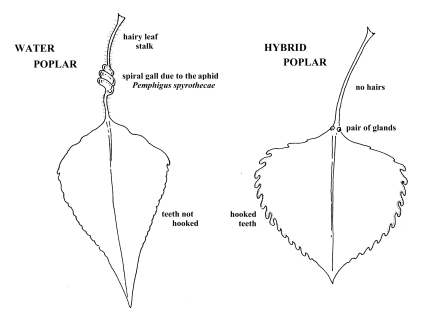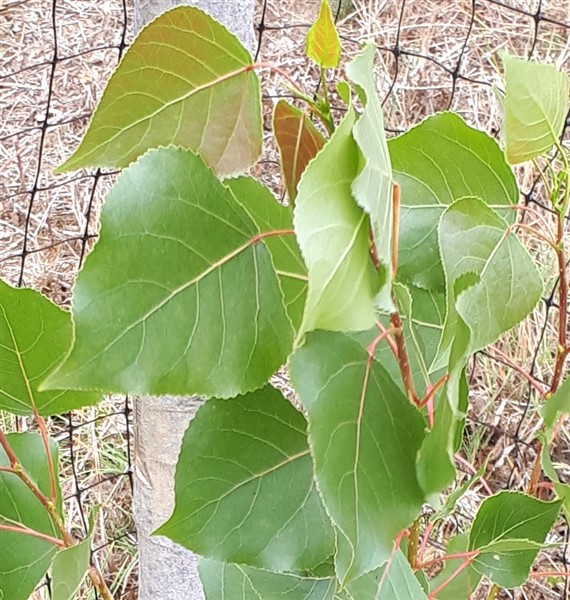The native Black polar Populus nigra ssp. betulifolia is one of the rarest species of tree in Britain. It is dioecious and there are only around 7,000 mature trees left in the UK, of which just some 600 are female. The remaining trees have very limited genetic diversity and new diseases are wiping out whole swathes of the species.
A good description of the species, its history, how to recognise it, why it is important, why it declined, how it reproduces and what is being done to conserve the Black poplar can be found in Sussex Wildlife Trust’s leaflet here.
Identifying the ‘Native’ Black poplar from the Italian Black Poplar – Ken Adams
Populus x canadensis (Populus nigra nigra x deltoides) Italian Black Poplar
Leaves with cartilaginous margins, thin, lamina not leathery, light green, rather large, teeth rounded, hooked and curving forwards towards the apex, base truncate to cordate, two glands at junction of petiole and lamina, petiole and leaf veins glabrous. Terminal shoot leaves similar to the others. Trunk and branches without burring or bosses. Branches ascending, not downward arching. Bark deeply fissured with rounded spaghetti-like segments, usually grey in colour. Often supports Mistletoe. Never supports the aphids Pemphigus spyrothecae, P. bursorius or P. populinigrae agg.
Populus nigra betulifolia (Water Polar, European Black Poplar, ‘Native’ Black Poplar)
Leaves without catilagenous margins, lamina rather thick and leathery, deep green, margin sinuous around most of circumference, may have slightly hooked teeth towards the base. Base of mature leaves cuneate to truncate but never cordate. No glands at junction of petiole and lamina, petiole and main veins below softly hairy in spring. Terminal shoot leaves markedly diamond shaped with cuneate base and long pointed apex. Trunk and branches usually burred and bossed with epicormic shoots. Trunk black, fissured with slit-like fissures as if cut by a knife. Upper branches may however have grey spaghetti-like bark in large mature trees. Main branches arching over in wide arcs, often touching the ground. N.B. in recently pollarded trees these may be steeply ascending for the first 5-6 years. Does not support Mistletoe. The aphids Pemphigus spyrothecae, P. bursorius or P. populinigrae agg. all specific to P. nigra (including P. nigra nigra, P. nigra ilalica (Lombardy) and P. nigra betulifolia.


Helping to save the Black poplar in the Dallington Forest Project area
In the spring of 2020, 27 Black poplar saplings grown from clones of mature Sussex trees were planted in the parishes of Brightling and Dallington, 5 of them within the Dallington Forest Project Area.

Here is a report on the planting from the Tree Warden for the two parishes.